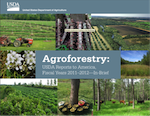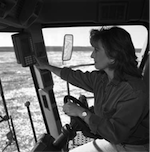Agroforestry People
News about people in the North American agroforestry community
- Details
- Parent Category: 2014 Vol. 20
- Category: Volume 20 No. 1 July 2014
News about people in the North American agroforestry community
Welcome to the July, 2014 edition of the Temperate Agroforester. The newsletter welcomes contributions for future issues and input or feedback about anything that you read in this issue.

One of the challenges under current land management practices is to increase food and soil security to meet projected trends in food production, while maintaining the resilience to climate change. This book provides a forum for researchers to access the most recent developments in enhancing carbon sinks and minimizing greenhouse gas emissions. It suggests that policies and practices integrating microbial technology, modern crop cultivars, conservation practices, increased manure application, organic farming and agroforestry have a greater capacity to sequester carbon and reduce carbon-based greenhouse gases, leading to more robust agroecosystems compared to conventional agriculture.

Forest farming in North America is sometimes a family tradition passed down through generations and sometimes a much larger concerted community effort. Regardless of how it is carried out, the internet is changing the way we learn about and share forest farming techniques. The Forest Farming Video Series (www.youtube.com/user/exforestfarming) is an initiative within eXtension’s forest farming network (www.extension.org/forest_farming). It is sponsored by the US Department of Agriculture’s National Institute for Food and Agriculture and Forest Service and brings together forest farming experts and experienced agroforesters from across North America to develop, film, and broadcast informative interviews, production techniques, and on-the-ground demonstrations.
WASHINGTON, October 28, 2013 - Agriculture Secretary Tom Vilsack today released the first-ever report on USDA's role advancing agroforestry. Agroforestry: USDA Reports to America details how agroforestry practices are helping farmers, ranchers and woodland owners enhance agricultural productivity, protect the environment and increase profits.

Our USDA colleagues have been busy on the agroforestry file since the release of the USDA Agroforestry Strategic Framework by USDA Deputy Secretary Kathleen Merrigan in June, 2011, at the 12th NAAC in Athens, Georgia, and which was then presented in more detail by the National Agroforestry Center (NAC) Director, Andy Mason.
Over 1,000 people participated in the 3rd WCA, theme - “Trees For Life”, in India, including people from more than 80 countries – tropical, sub-tropical and temperate (www.wca2014.org). Temperate agroforestry is a part of a larger picture of world agroforestry and it is important for North American researchers and practitioners to get together with counterparts from other parts of the world. Agroforesters from Canada and the United States that attended included Raju Soolanayakanahally (Agriculture and Agri-Food Canada), Shibu Jose (Univ. of Missouri), P.K. Nair (Univ. of Florida) and Marney Isaac (Univ. of Toronto), to name a few.

Following the drought and dust storms of the 1930s the US federal government’s response was to invest $13.8 million to plant more than 200 million trees and shrubs throughout the Great Plains. These planting were initially established to reduce windblown soil, but research suggests there is an additional benefit that would surprise many agricultural producers.